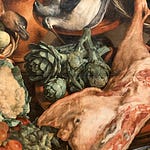There’s a bar near my apartment that isn’t a gay bar, not quite. At least it doesn’t have a little rainbow flag draped in the window, nor flashing pop videos scrolling across multiple widescreens, nor, I would imagine, a majority, explicitly “gay” clientele. There’s something queer about it though, genuinely queer. I visited this weekend with some out-of-towners after dinner, taking them down the narrow alley and through the nondescript door. Inside some friends were already dancing by the DJ, playing reggaetón off a laptop on one of the bar tables. The two barmaids danced and chatted as they served. They wore flawless full beat, one dressed in a figure hugging black halter neck with big gold clasps that pushed up her breasts, the other in a leopard print mini dress. The Spanish word for this type of strapless top is palabra de honor: “word of honour”. Around the edges of the bar, young Moroccan men with impeccable fades and trainers quietly drew on their hookah pipes. The night was swelling, the atmosphere not cruisy, but with the same awareness of bodies, of looking. The bar itself is lit by brass lamps speckled with coloured glass, dimly illuminating the dark red walls and checkerboard floor. All around are draped velvets and tassels, and every available surface has a framed photograph or poster of a film star, a diva in her prime. Not any film star: they are all, without exception, pictures of Sara Montiel, the Queen of Spanish cinema in the 1960s. As we sat at the bar, my friend tried to describe the tone. “It’s camp,” one said, “but that real camp, that sincere adoration.” It’s true, but it touched something else in me, a very specific memory of an aesthetic that is loaded with a desire that overflows the orientalist limits, that wants, despite itself. “Pink Narcissus,” I said.
Pink Narcissus was the masterpiece of the American artist James Bidgood, who died yesterday aged 89. I first saw it when I was 16, which I count as an early miracle in my life. It could just as easily, more easily, have never happened: what are the chances that some teenage kid living in the north of England finds himself in the situation where a friend’s mother just happens to have a taste for gay arthouse, a DVD player, and a handful of newly released treasures for us to pick through? And what are the chances that a film made more than thirty years earlier, existing on the edge of a queer culture for devotees only, with an unknown director, would be nurtured back into public light by the desire of devotees to name him, to get it re-released, to give it its proper place? And yet there we were, a bunch of teenage outcasts, drinking warm Pepsi and huddling on the floor in front of the TV, waiting to see what came out. It was on that small TV screen that I had first seen Nosferatu (1922) some years early, a seminal moment in filmmaking history and in shaping my own early creative consciousness. Watching Pink Narcissus was also seminal for me: very, very seminal.
The film is remarkable, both in its content, and in its history. The story is one of desire, and Bidgood was an ideal director for the subject, a gay man who seemed preternaturally attuned to reading the world through a series of visual moments. Narrative can overwhelm the telling of desire, which transmits itself through discrete moments of pleasure, sense, touch, want. And so it is here, as the camera follows a young hustler (played by Bobby Kendall) from the comfort of his boudoir as he slips into a series of erotic dreams, imagining himself as a Roman slave boy awaiting martyrdom for the pleasure of a Caesar, as a matador on the hot sand, cruising the urinals and face-fucking his pissqueen, as both Sultan and his harem boy, a shepherd and even, perhaps, as himself, another New York rentboy selling his ass, again to himself. Narcissus is the theme: self-love, self-desire, self-idolisation. There is plenty of looking in the film (it starts with Kendall appraising his ass in skin-tight white jeans in a hall of mirrors) but precious little sex. Masturbation, however, is everywhere, from humping the soft ground to jerking off in his silk sheets, and masturbation of things, too: leaves, pearls and so on. These scenarios of self-desire unfold in order for you, the viewer, to find yourself partly, vicariously, as a beautiful engine of lust, and partly as a voyeur, looking into his dreams, where there is no space for you.
Yet the narrative is so light as to be barely visible. The motor of the film and of the viewer's enjoyment is the remarkable aesthetic vision of Bidgood’s. It’s hardly a surprise that he displayed a mastery of depicting the young male body as both subject or object. As a photographer he cut his teeth on the “men’s physique” magazines of the 50s and 60s, softcore disguised as bodybuilding mags to evade America’s moral censors. His colour photography for a genre of magazines with such glorious titles as Muscleboy, The Young Physique and Demi-Gods are aesthetic delights in themselves, as discussed by fellow filmmaker William E. Jones in his excellent Art Forum profile a few years ago, yet are restrained by the commercial medium.
In Pink Narcissus he lets that vision off the leash. The colour palette alone is a pure sensation, with tones of purples, lavenders, rose and peach, buttercup and lemon falling across the screen like a camera passing through a series of curtains, not to mention the bruise blue and purple storm clouds overhead. The sets are more suggestions than depictions, delirious hints of a place that echo the dream states the film is set in, avatars for a type of place more than a rendition of the place itself. And yet what is most remarkable about the film is the scale of it, given the production constraints. It took Bidgood seven years to produce the film, and aside from a few shots filmed in a loft lent to him by the softcore production and distribution company Sherpix, the entire film was made in his small Manhattan apartment. It’s a triumph of the handmade, the plastic, in every sense of the word, from the yellow butterfly whose entrance opens the film to the carved foam urinals in which the pissqueen fucks the floor. These constraints are what make the film so expansive (a common paradox of creativity); the time taken by one man on a tiny budget to produce each scene means every single frame is considered, composed and executed. At times, the shots veer so far into abstract compositions of startling beauty, such as the cock ejaculating falling pearls, that they look like scenes from Oskar Fischinger films, the animator and filmmaker whose abstract productions represent a dead branch of Hollywood film. Fischinger actually contributed to the production of Disney’s Fantasia (1940), a movie which shares some of the same soundtrack as Pink Narcissus, although demanded his name be removed from the credits after Disney insisted on more representation within the scenes he’d overseen.
What is astonishing is how pornographic the film is (Pink Narcissus, that is, not Fantasia). To those of us raised on the internet, the technics of the sex is quite simply very softcore. Aside from a little face-fucking, there’s very little action; a little frotting, some dick swinging and suggested masturbation. Yet in the intensity of the scenes, the suggestions of modily fluids and mulching soil, the fecundity of the whole thing, it’s not merely erotic but super pornographic. It walks the same razor line as Genet, turning the abject, the pissoir, the athletic support, into the hottest and most beautiful object of both consideration and, importantly, of lust. There’s absolutely zero shame in the intention of the film being the enjoyment of this young hustler’s body, in his sexual arousal, in getting you hard too. Despite its softcore nature, perhaps that’s what has helped keep the film at arms length from full recuperation into an arthouse staple.
Despite its themes of European myth and orientalist fantasy, there’s something extremely American about the film, something plastic and confected. That’s its strength. It was started, as Jones points out, around the time Susan Sontag wrote Notes on Camp, and to my mind it hits Sontag’s defining characteristic of pure camp: despite it being a lot of fun, it’s serious. You could giggle your way through the film today, with its leather-clad pissqueen and preposterously brooding twink lead, but I think that misses something important about meaning it, about trying to forge a new visual language for wanting to fuck men - always a risk when laughing at campness. You must mean it to spend seven years making it in your bedroom, so to speak. And you must mean it to then take your name off it when the producers release it in a state you’re not happy with, like Disney did to Fischinger, and like Sherpix did to James Bidgood. Unhappy with the soundtrack and edit, he destroyed the storyboard and sent this little masterpiece out into the world under the director “Anonymous”. So he stayed, and perhaps would have been unrecognised in life or death, were it not for the writer Bruce Benderson, who sought out the director then living in poverty in New York and wrote a monograph on his work and photography. The intervening years hadn’t seen him make any more films, returning instead to photography, and Pink Narcissus was variously attributed to other sixties queer film pioneers such as Andy Warhol or Jack Smith. But it wasn’t Warhol and it wasn’t Smith, it was Bidgood. Thanks to Benderson’s work, his name was reattached to the film and he received a reappraisal in the last two decades of his life, finding a new audience, including, miraculously, a sixteen year old me. Perhaps he hasn’t left an enormous body of work on his death, but what he has left is spectacular, beautiful, hot. Tonight we can celebrate his life by rewatching Pink Narcissus and, on sleeping, letting it cloud our wet dreams in a fuchsia mist.
All stills taken from Pink Narcissus
Paid subscribers get access to the entire archive of 80+ essays, including posts such as this essay on meaningless sex and queer pleasure, this on Freddie Mercury as “gay icon”, this one on housing and sex in law and culture, and this article about Quentin Crisp, Larry Kramer and the 80s.




















Share this post